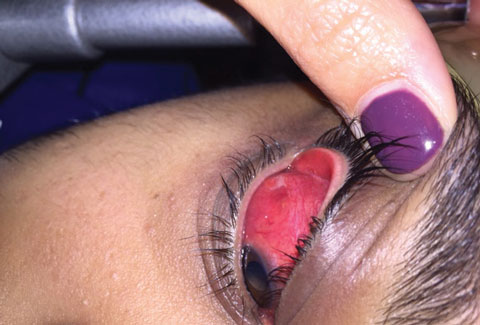 |
Q:
I saw a 24-year-old Hispanic male for a second opinion regarding a red, painful right eye, which was managed by a local MD. Four months of treatment for conjunctivitis with ophthalmic moxifloxacin, ophthalmic prednisolone acetate and, most recently, oral penicillin, has provided no relief. Could a retinal detachment (RD) in the right eye with scleral buckle repair from 2012 have anything to do with this?
A:
“Two key pieces of this patient’s ocular history are pertinent in solving this quandary,” says Chelsea Miller, OD, who is in a disease-oriented practice in Racine, Wis. First is the patient’s retinal detachment with vitrectomy and scleral buckle repair, she says, and the second is the acute onset of symptoms that did not resolve with treatment over several months.
An important finding is a granulomatous lesion on the sclera at the center of the conjunctival injection. “Many times, these cases will present with a complaint of generalized pain without ocular findings, so getting a good ocular history is very important,” according to Dr. Miller.1 It’s also important to look for buckle exposure in patients with a history of buckle repair, she says, because “typically, buckle infections will be associated with some degree of buckle exposure, especially in cases that present several months to years post-RD repair.”1,2
 |
| The patient presented with significant lid swelling. |
Treating the Infection Management is time sensitive, according to Dr. Miller, and this patient should be referred back to his retina specialist for a suspected scleral buckle infection.“Without proper care, preceptal cellulitis, endophthalmitis or panophthalmitis can occur.”2,3 Rare cases can be managed with systemic intravenous antibiotic and corticosteroid treatment; but in most cases, the buckle needs to be removed.2
“Though a wide microbial spectrum causes these infections, Staphylococcus epidermidis and Staphylococcus aureus are the most common organisms,” explains Dr. Miller.1,3 Vancomycin can be an effective treatment option, and ciprofloxacin can be effective in treating other gram-positive and some gram-negative buckle bacterial infections, according to Dr. Miller.
 |
| A 4mm round lesion was noted on the inferior temporal conjunctiva with a central umbilication, which had white discharge when expressed. |
Weighing the Risks
Removing the buckle is often necessary, but is not without risks, Dr. Miller says. “The biggest problems associated with scleral buckle removal are scleral perforation (~13%) and recurrence of a retinal detachment (~7%),” Dr. Miller says.4 “Retinal detachment usually occurs within five days to 50 months of removal of the buckle, with 70% to 80% of these being within 90 to 180 days of buckle removal.”1,3
Other indications for buckle removal include long-standing diplopia, ocular pain, optic nerve injury, anterior segment ischemia and macular distortion, according to Dr. Miller. “Although buckle exposure is a significant risk factor for scleral buckle infection, this is not necessarily an indication for removal if the patient is asymptomatic.1 However, careful patient education regarding signs and symptoms of scleral buckle infection is a must with these patients.” Your awareness and knowledge can save them from incorrect diagnosis and treatment.
|
1. Kazi MS, Sharma VR, Kumar S, Bhende P. Indications and outcomes of scleral buckle removal in a tertiary eye care center in South India. Oman J Ophthalmol. 2015;8:171-4. 2. Chhablani J, Nayak S, Jindal A, et al. Scleral buckle infections: microbiological spectrum and antimicrobial susceptibility. J Ophthal Inflamm Infect. 2013;3:67. 3. Deokule S, Reginald A, Callear A. Scleral explants removal: the last decade. Eye (Lond.). 2003;17:697-700. 4. Boyd S, Wu L. Management of Complications in Ophthalmic Surgery. Panama City, Panama: Jaypee-Highlights Medical Publishers; 2011. |

